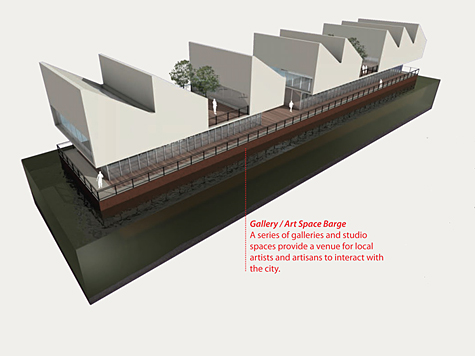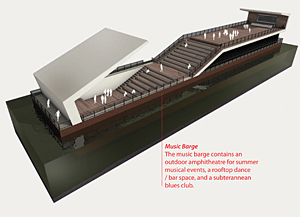
Nevena Krilic’s winning design for the 2010 Steedman Competition would replace lost Mississippi River islands and sand bars — washed away by a century of industrial channeling — with a mobile fleet of 15 barges housing public, cultural and retail spaces. Pictured is Krilic’s proposed Gallery/Art Space Barge.
Toronto architect Nevena Krilic has won Washington University’s 2010 Steedman Fellowship in Architecture International Design Competition.
Sponsored by the College of Architecture in the Sam Fox School of Design & Visual Arts, the biennial competition is open to young architects from around the world and carries a $30,000 first place award to support study and research abroad — the largest such award in the United States.
Krilic received both a bachelor’s degree in environmental studies and a Master of Architecture from the University of Waterloo, Ontario, in 2001 and 2005, respectively. Her work was chosen from a field of 27 submissions representing Austria, Canada, France, Greece, India, Italy, Mexico, Spain, the United States and Vietnam.
She will use the award to study post-socialist architecture in Eastern Europe.

“Reframing Saarinen’s Arch”
Titled “Reframing Saarinen’s Arch: Addressing the North-South Axis,” the 2010 Steedman Competition centered on the relationship between the City of St. Louis and the Mississippi River. Just as Eero Saarinen’s iconic Gateway Arch stands as a metaphoric “gateway to the west,” so does the Mississippi itself serve as gateway to the Gulf of Mexico, the Atlantic Ocean and the world beyond.
“The natural inclination of the Mississippi River is a meandering state of flux, constantly remapping itself in its floodplain,” Krilic notes in her winning proposal, “Urban Armada: Anchor & Transform.” Yet generations of efforts to control the river have channeled and quickened its flow, erasing islands, sand bars, bends and bayous.
Krilic’s design would replace this lost geography with a mobile fleet of 15 barges — housing a variety of public, cultural and retail spaces — stationed along the riverfront in groups of three.
“The barge, as a tectonic unit, allows for the inhabitation of the landscape without complete permanence,” she explains. “The idea of the barge as a moving urban artifact is further enforced when all 15 barges group together as an armada for the Fair St. Louis,” the city’s annual July 4 celebration. “This aspect could be further explored by deploying the armada on a Sawyer-esque journey down the Mississippi, as a vessel of St. Louis culture.”
Jury chair Alex Krieger, professor of practice and interim chair of the Department of Urban Planning & Design at the Harvard Graduate School of Design (GSD), noted that, “Among the many impressive qualities of this proposal is the careful analysis of the banks of the Mississippi River and the identification of five strategic places along the river to establish expanded engagement with the river.
“This barge armada, no longer for the purpose of ferrying goods, now serves to energize the urbanized area of the river,” Krieger adds, “ferrying citizens from place to place and across the river.”
Alternates and honorable mentions
First alternate is Philip Lee of Brooklyn for “PUSH-PULL Landscapes at the American Bottoms,” which proposed an imaginative system of u-shaped levees, the upper parts of which would form a continuous public promenade while also acting as wetlands to temporarily absorb water during floods. Lee received a Master of Architecture degree in 2003 from the Rice University School of Architecture and a Bachelor of Science degree in architecture in 1998 from the University of Michigan.
Second alternate is Michael Hughes of New York for “Toxic-Mounds/Plume Parks,” which explored bio-remediation of the several thousand brownfields lining the Mississippi’s western banks, and which was inspired by nearby Cahokia Indian Mounds. Hughes received a Bachelor of Architecture degree in 2009 from Cornell University.
Four honorable mentions were awarded, to John Arthur Liu of New York; Sony Devabhaktuni of Paris, France; Dimitri Gourdoukis of Thessaloniki, Greece; and Andrew Moddrell of Chicago.
In addition to Krieger, jurors included Joan Busquets, the Martin Bucksbaum Professor in Practice of Urban Planning and Design at the GSD; Dorothée Imbert, director of the Sam Fox School’s newly established Master of Landscape Architecture program; Marilyn Taylor, dean of the School of Design at the University of Pennsylvania; and Charles Waldheim, professor and chair of landscape architecture at the GSD.
Steedman Fellowship
Granted since 1925, the Steedman Fellowship is awarded biannually on the basis of an International Design Competition. The competition is supported by an endowment given to the Sam Fox School’s College School of Architecture in honor of James Harrison Steedman, who received a degree in mechanical engineering from Washington University in 1889. He was a decorated veteran of World War I, and passed away at the family’s home in Montecito, CA, in 1921. The memorial was established by Steedman’s widow, Mrs. Alexander Weddel, and his brother, George.
In addition, the Steedman Summer Travel Fellowship is awarded annually to a current architecture student to support travel and the investigation of an architectural topic of the student’s choosing. The winner of the 2010 fellowship is June Kim, who is pursuing a dual Master of Architecture/Master of Urban Design degree. The award will support a five-week study of floating settlements in Cambodia.
For more information about the Steedman Fellowship, visit www.steedmancompetition.com.